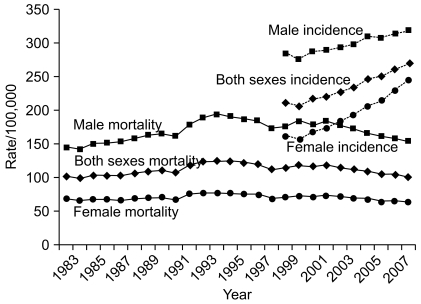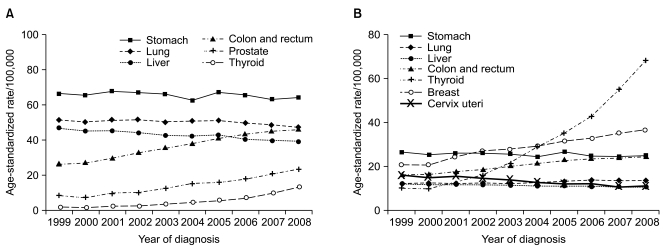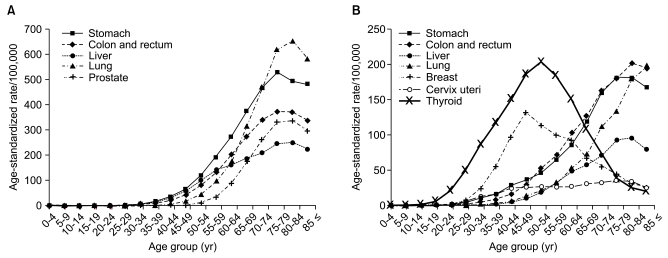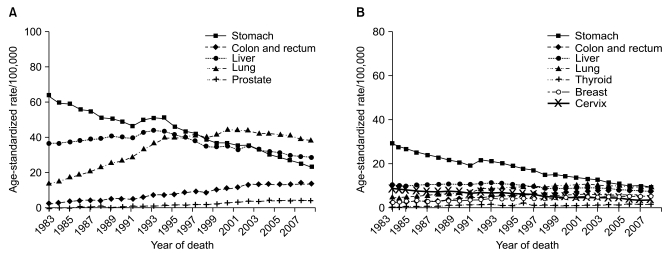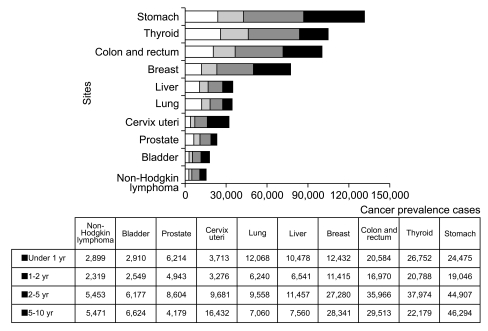Cancer Res Treat.
2011 Mar;43(1):1-11.
Cancer Statistics in Korea: Incidence, Mortality, Survival, and Prevalence in 2008
- Affiliations
-
- 1The Korea Central Cancer Registry, Division of Cancer Registration and Surveillance, National Cancer Center, Goyang, Korea. shpark@ncc.re.kr
- 2National Cancer Control Institute, National Cancer Center, Goyang, Korea.
Abstract
- PURPOSE
This paper overviews the nationwide cancer statistics including incidence, mortality, survival and prevalence, and their trends in Korea based on the year 2008 cancer incidence data.
MATERIALS AND METHODS
Incidence data from 1993 to 2008 were obtained from the Korea National Cancer Incidence Database, and the vital status was followed through December 31, 2009. Mortality data from 1983 to 2008 were obtained from the Korea National Statistics Office. Crude rates and age-standardized rates for incidence, mortality, prevalence and relative survival were calculated.
RESULTS
There were 178,816 cancer cases and 68,912 cancer deaths observed during year 2008 and 724,663 10-year cancer prevalent cases as of January 1, 2009 in Korea. The incidence rate for all cancer combined showed an annual increase of 3.1% from 1999 to 2008.
CONCLUSION
With significantly increasing cancer incidence, Korea faces a large cancer burden and efficient cancer control programs are essential.
MeSH Terms
Figure
Reference
-
1. National Statistical Office, 2009 [Internet]. 2009. cited 2011 Jan 14. Daejeon: National Statistical Office;Available from: http://kostat.go.kr .2. Ministry for Heath, Welfare and Family Affairs. Annual report of cancer incidence (2006) and survival (1993-2006) in Korea. 2009. Seoul: Ministry for Heath, Welfare and Family Affairs.3. Won YJ, Sung J, Jung KW, Kong HJ, Park S, Shin HR, et al. Nationwide cancer incidence in Korea, 2003-2005. Cancer Res Treat. 2009; 41:122–131. PMID: 19809561.
Article4. Shin HR, Won YJ, Jung KW, Kong HJ, Yim SH, Lee JK, et al. Nationwide cancer incidence in Korea, 1999~2001; first result using the national cancer incidence database. Cancer Res Treat. 2005; 37:325–331. PMID: 19956367.
Article5. Fritz A, Percy C, Jack A, Shanmugaratnam K, Sobin L, Parkin DM, et al. International classification of diseases for oncology. 2000. 3rd ed. Geneva: World Health Organization.6. World Health Organization. Manual of the international statistical classification of diseases, injuries, and causes of death. 1992. 10th rev. Geneva: World Health Organization.7. Segi M. Cancer mortality for selected sites in 24 countries (1950-1957). 1960. Sendai: Tohoku University School of Medicine.8. Altekruse SF, Kosary CL, Krapcho M, Neyman N, Aminou R, Waldron W. SEER cancer statistics review, 1975-2007. 2010. Bethesda, MD: National Cancer Institute.9. SEER*Stat Program, version 6.6.1 [Internet]. National Cancer Institute. 2011. cited 2011 Jan 14. Bethsda, MD: National Cancer Institute;Available from: http://seer.cancer.gov/seerstat/ .10. Ederer F, Heise H. Instructions to IBM programmers in processing survival computations. Methodological note No. 10. 1959. Bethesda, MD: National Cancer Institute.11. Dickman P [Internet]. cited 2009 Apr 14. Stockholm: PaulDickman.com;Available from: http//www.pauldickman.com .12. Davies L, Welch HG. Increasing incidence of thyroid cancer in the United States, 1973-2002. JAMA. 2006; 295:2164–2167. PMID: 16684987.
Article13. Enewold L, Zhu K, Ron E, Marrogi AJ, Stojadinovic A, Peoples GE, et al. Rising thyroid cancer incidence in the United States by demographic and tumor characteristics, 1980-2005. Cancer Epidemiol Biomarkers Prev. 2009; 18:784–791. PMID: 19240234.
Article14. Curado MP, Edwards B, Shin HR, Stom H, Ferlay J, Heanue M. Cancer incidence in five continents. 2007. vol.9. Lyon: IARC.15. Jung KW, Yim SH, Kong HJ, Hwang SY, Won YJ, Lee JK, et al. Cancer survival in Korea 1993-2002: a population-based study. J Korean Med Sci. 2007; 22(Suppl):S5–S10. PMID: 17923755.
Article
- Full Text Links
- Actions
-
Cited
- CITED
-
- Close
- Share
- Similar articles
-
- Cancer Statistics in Korea: Incidence, Mortality, Survival, and Prevalence in 2012
- Cancer Statistics in Korea: Incidence, Mortality, Survival, and Prevalence in 2016
- Cancer Statistics in Korea: Incidence, Mortality, Survival, and Prevalence in 2014
- Cancer Statistics in Korea: Incidence, Mortality, Survival, and Prevalence in 2015
- Cancer Statistics in Korea: Incidence, Mortality, Survival, andPrevalence in 2017

